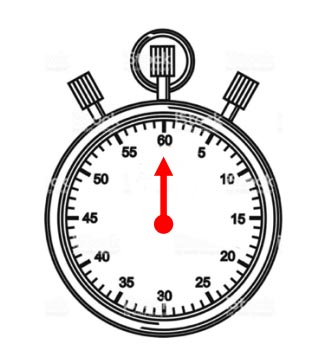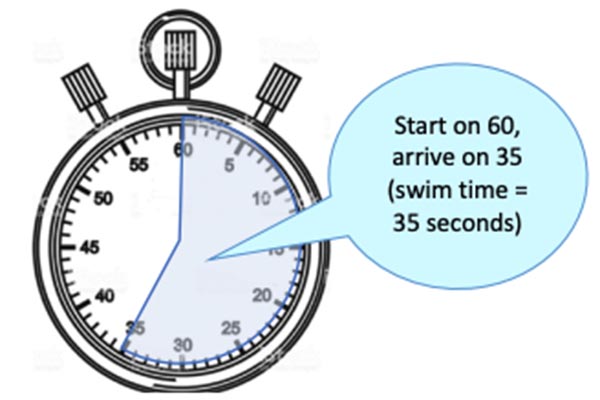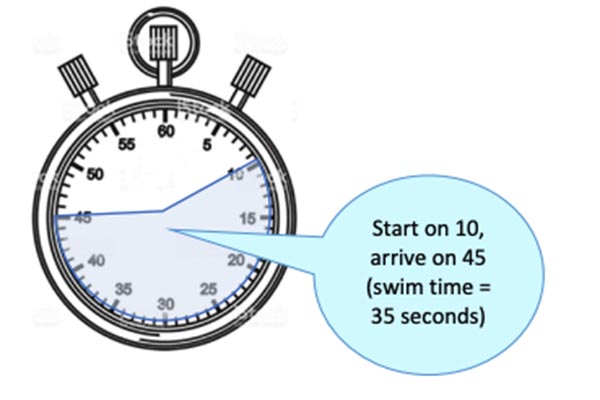Step 1: Time yourself (pace awareness)

Knowing your speed is the first step. You will need either a waterproof watch or pace clock which is often on the wall of most swimming pools.
If you are using a pace clock, the easiest way to get your time is to leave on “the top”, when the hand gets to the 60 (or sometimes 00). After you’ve swum the distance that you want to time, glance back at the clock. This will help you determine what your time is. (FIGURE 1.1)
For example, you swim a 25 meters/yards and leave the wall at 60 (or 00).
If the hand was at 35 when you touched the wall at the other end, that means you swam the length (25 m/yd) in 35 seconds. (FIGURE 1.2)
However, if you left the wall on the 10 and touched the wall on the 45, then you’ll have to do some simple math to figure out your time. E.g. 45 – 10 = 35
This means you swam the length in 35 seconds (FIGURE 1.3)


Step 2: Pace yourself
I would recommend you start with repetitions of short distances such as a 25 meters/yards.
For example, 8 x 25 m/yd with about 10 seconds rest in between each repetition.
The goal is to swim at a steady (medium) speed which would allow you to swim each repetition at about the same speed.
This step is not easy for swimmers who are new to timing themselves or using a clock. This exercise may take a few tries before you achieve a similar speed or time for each repetition. This is when step 3 takes place.
Step 3: Send-off intervals (starts)
Constant pace (speed) and rest are the foundation for developing your endurance and are best accomplished by swimming intervals. This ensures consistency and accountability of swimming pace and rest.
In swimming workouts, most swim sets are on send-off intervals (starts).
This means you focus on when you start each repetition, not on the amount of rest in between the repetitions.
Training with intervals is far more beneficial for developing your endurance than doing repetitions based on how much rest you want to get after each swim, regardless your speed or intensity.
Example: 8 x 25 meters/yards on 50” start
Following Step 2, if you swam 8 x 25 m/yd at an average pace of 40 seconds per 25 m/yd, then I would recommend to start with the following swim set:
8 x 25 m/yd on 50” start (8 x 25 m/yd starting each 25 m/yd every 50 seconds)
This means you will be starting the first 25 m/yd when the clock hand is on 60 (or 00) then you will start the second 25 m/yd when the hand is on 50, the third 25 m/yd when the hand is on 40, the fourth on 30, etc.
Don’t forget to always glance back at the clock at the end of each 25 m/yd to be aware of your pace.
For your first swim sets, the goal is to maintain a steady and constant pace for each repetition by having about 10 seconds rest per repetition. This is to ensure that you will develop your endurance.
Progression example: 8 x 25 m/yd on 45” start
If the swim set becomes too easy because you get more than 10 seconds rest for each repetition, then you will need to reduce your interval by changing your start time to keep a maximum of 10 seconds rest between the repetitions.
For instance, the set would become 8 x 25 m/yd on 45” start (starting each 25 m/yd every 45 seconds) instead of every 50 seconds.
This means you will be starting the first 25 m/yd when the clock hand is on 60 (or 00) then you will start the second 25 m/yd when the hand is on 45, the third 25 m/yd when the hand is on 30, the fourth on 15, etc.
Step 4: Increase short distance repetitions then distances
Why swim lots of short distance repetitions?
Swimming a long distance without stopping is likely to cause harmful technical and physiological effects.
Swimming 10 minutes non-stop will use the same amount of energy as swimming 20 x 30 seconds with 5 to 10 seconds rest between each 30 seconds block. However the 20 x 30 second swim set is a lot more beneficial:
- Technically (you can focus and maintain a better technique over a longer time),
- Physiologically (you can maintain a higher intensity and pace over short repetitions),
- Mentally (you can maintain a fresher nervous system throughout the set).
To develop your endurance, prioritize short distance repetitions with a about 10” rest between repetitions.
- 4 x 100 m/yd (R: 10”) * is more beneficial than doing 400 m/yd without stopping
- 8 x 50 m/yd (R: 10”) is more beneficial than doing 4 x 100 m/yd
- 16 x 25 m/yd (R: 10”) is also more beneficial than doing 8 x 50 m/yd
* R = Rest ‘ = minutes “ = seconds
In the longer term, the goal is to achieve a 20 minute set
Below is an example of progression:
- 8 x 25 m/yd on 45” start – Total of 200 m/yd (6 minutes)
Once the above is constantly achieved a few times, proceed to the next step:
- 2 x (6 x 25 m/yd on 45” start + 50 m/yd on 1’30 start ) – Total of 400 m/yd (12 minutes)
In a longer term:
- 3 x (4 x 25 m/yd on 40” start + 2 x 50 m/yd on 1’20 start) – Total of 600 m/yd (16 minutes)
Then:
- 12 x 50 m/yd on 1’20 start – Total of 600 m/yd (16 minutes)
Then:
- 2 x (6 x 50 m/yd on 1’15 start + 100 m/yd on 2’30 start) – Total of 800 m/yd (20 minutes)
Eventually:
- 16 x 50 m/yd on 1’15 start then 8 x 100 m/yd on 2’30 start


